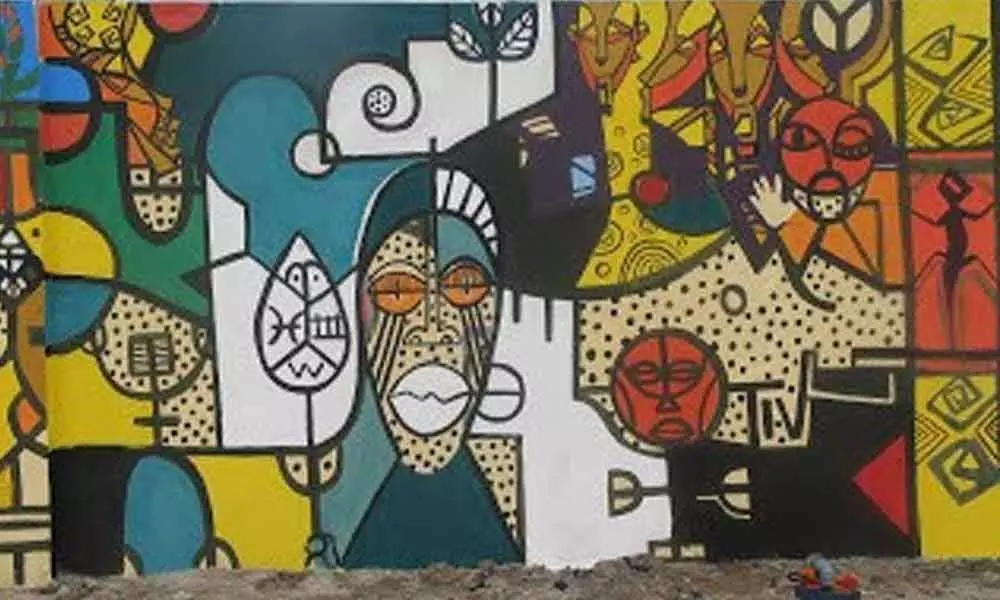Live
- 13 killed, 18 injured as landslides, flash floods hit Indonesia's North Sumatra province
- Israeli PM seeks additional delay of testimony in court for criminal trial
- JAIN International Residential School, Bengaluru jointly with The Sports School to announce India’s First Integrated Scholarship Future25
- Sale certificate issued in pursuance to a court's auction not required to be stamped: Supreme Court
- Andhra Pradesh: Jagan flays Chandrababu-led govt for neglect of education
- Sri Lanka issues flood warnings for 12 flood-prone river basin areas
- IPL 2025 Auction: Venkatesh Iyer sold to KKR for Rs 23.75 cr, Stoinis joins PBKS for Rs 11 crore
- Kharge to lead Opposition strategy meeting as Parliament session kicks off on Monday
- Three killed in firing as violence breaks out amid Sambhal mosque survey in UP
- IPL 2025 Auction: Ravichandran Ashwin, Rachin Ravindra return to Chennai Super Kings
Just In

Nigerian contemporary art booms and prices soar.
First there was Tutu, the "African Mona Lisa" sold last year for 1.5 million dollars. Then a second portrait by revered Nigerian painter Ben Enwonwu, called Christine, sold in mid-October, for 1.4 million dollars.
Both record sales of famous works by the late "father of African modernism", captured the emergence of Nigeria's art market.
A decade ago, major African artists were largely absent from international auctions. But the continent is now a major attraction in contemporary and modern art. Since his death in 1994, Enwonwu's star has only risen, epitomising the growing industry and value for art.
His two masterpieces, were sold by two of London's most prestigious auction houses, Bonhams and Sotheby's. "Africa is one of the fastest growing markets in the art world today, and Nigeria is equal on the top with South Africa," Giles Peppiatt, director of African art at Bonhams, told AFP.
His auction house was one of the first in Europe to bet big on the continent with "Africa Now" beginning in 2007, auctioning African art as a stand alone sale.
In the vibrant commercial capital of Lagos, with 20 million people, its cultural season, awash with literary fashion and art festivals, culminates this weekend with the international fair "ART X". Three years after it began, the fair has emerged as one of the premier art events on the continent, exhibiting the rich array of African modern and contemporary art.
The famous Tutu, "lost" for almost 40 years and spectacularly found in 2018, almost by chance, in a London apartment, was the surprise attraction of the last edition, drawing several thousand attendees.
A show-reel of Nollywood's actresses, traditional leaders, wealthy collectors and artists trooped to the painting of the mysterious Yoruba princess. At the end of the year, Nigeria's economic-hub becomes awash with glamor and arts.
Thousands of visitors rush from one exhibition to another, from ART X to the Lagos Biennale of contemporary art, Lagos fashion week and LagosPhoto, all of which take place between October and November.
But alongside the art, is an increasing market and appetite amongst investors and collectors. New galleries like Art Twenty One have opened in recent years.
And the auction house Art House Contemporary Limited, whose turnover is more modest than that of its European peers, regularly exhibits the most notable artists in the region: Enwonwu, Yusuf Grillo, El Anatsui or Peju Alatise.
Collectors or investors?
This year, some twenty galleries and more than 90 artists will be represented at ART X, with representatives from Tate Modern (London) and Smithsonian (Washington) expected to attend.
Creative audio installations by renowned artist, Emeka Ogboh, based between Berlin and Lagos, will grace the background of the anticipated fouth edition of the fair.
If the appetite for contemporary African art continues to grow, apart from outliers that exceed one million dollars, the majority of works are still sold at "reasonable" prices in comparison with the rest of the world: "between $10,000 and $60,000," Peppiatt says.
"Events like Art X are changing the game, they enable cities like Lagos to shine and attract many enthusiastic collectors," he explains. "This is a very exciting moment."
The West African oil giant and largest economy on the continent has a growing middle class of rich bankers and industrialists, with a burgeoning appetite for purchasing contemporary art.
The biggest bids still take place in Europe, where the market is better structured, and better protected against fake works.
Yet collectors increasingly fly to buy works in London or New York and then bring them back to Africa, says Jess Castellote, director of the Yemisi Shyllon Museum of Art, a private museum that will open next year in the suburbs of Lagos.
"There are collectors, art lovers who want to reconnect with their culture, their legacy," he says, explaining that as well as art enthusiasts, serious investors have taken interest in art. In Nigeria, as in South Africa, multi-million dollar investment funds have sprung up to acquire works and resell them as dearly as possible, again betting on a rising demand for art.
"Rich Nigerians who used to spend 250,000 pounds ($320,000) on a watch or a luxury car now prefer to invest in a painting or a sculpture," Castellote says.

© 2024 Hyderabad Media House Limited/The Hans India. All rights reserved. Powered by hocalwire.com







